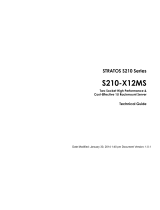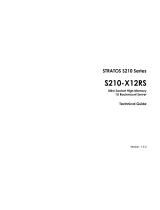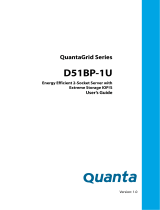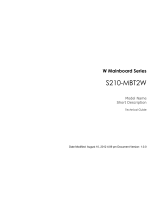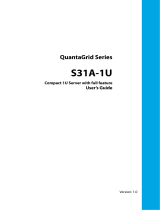Page is loading ...

STRATOS S210 Series
S210-X12RS
Ultra-Socket High Memory
1U Rackmount Server
User's Guide
Version: 1.0

CONVENTIONS
XV
Conventions
Several different typographic conventions are used throughout
this manual. Refer to the following examples for common
usage.
Bold type face denotes menu items, buttons and application
names.
Italic type face denotes references to other sections, and the
names of the folders, menus, programs, and files.
<Enter> type face denotes keyboard keys.
WARNING!
Warning information appears before the text it references and
should not be ignored as the content may prevent damage to
the device.
CAUTION!
CAUTIONS APPEAR BEFORE THE TEXT IT REFERENCES, SIMILAR TO
NOTES AND WARNINGS. CAUTIONS, HOWEVER, APPEAR IN CAPITAL
LETTERS AND CONTAIN VITAL HEALTH AND SAFETY INFORMATION.
Important:
Indicates information that is important to know for the proper
completion of a procedure, choice of an option, or completing a
task.
!
!
Note:
Highlights general or useful information and tips.

ACRONYMS
XVI
Acronyms
TERM DEFINITION
A/D Analog to Digital
ACPI Advanced Configuration and Power Interface
ASF Alerting Standard Forum
Asserted
Active-high (positive true) signals are asserted when in
the high electrical state (near power potential). Active-
low (negative true) signals are asserted when in the low
electrical state (near ground potential).
BIOS Basic Input/Output System
BIST Built-In Self Test
BMC
At the heart of the IPMI architecture is a microcontroller
called the Baseboard management controller (BMC)
Bridge
Circuitry connecting one computer bus to another,
allowing an agent on one to access the other
BSP Bootstrap processor
Byte 8-bit quantity
CLI Command Line Interface
CMOS
In terms of this specification, this describes the PC-AT
compatible region of battery-backed 128 bytes of
memory, which normally resides on the baseboard
CPU Central Processing Unit
Deasserted
A signal is deasserted when in the inactive state. Active-
low signal names have “_L” appended to the end of the
signal mnemonic. Active-high signal names have no “_L”
suffix. To reduce confusion when referring to active-high
and active-low signals, the terms one/zero, high/low, and
true/false are not used when describing signal states.
DTC Data Transfer Controller
EEPROM Electrically Erasable Programmable Read-Only Memory
EMP Emergency Management Port
FRU Field Replaceable Unit
GB 1024 MB.
GPIO General Purpose Input/Out
HSC Hot-Swap Controller
Hz Hertz (1 cycle/second)
I
2
C
Inter-Integrated Circuit bus
IANA Internet Assigned Numbers Authority
IBF Input buffer
ICH I/O Controller Hub
ICMB Intelligent Chassis Management Bus
IERR Internal Error
IP Internet Protocol
IPMB Intelligent Platform Management Bus

ACRONYMS
XVII
IPMI Intelligent Platform Management Interface
ITP In-Target Probe
KB 1024 bytes.
KCS Keyboard Controller Style
KVM Keyboard, Video, Mouse
LAN Local Area Network
LCD Liquid Crystal Display
LCT Lower Critical Threshold
LED Light Emitting Diode
LNCT Lower Non-Critical Threshold
LNRT Lower Non-Recoverable Threshold
LPC Low Pin Count
LSI Large Scale Integration
LUN Logical Unit Number
MAC Media Access Control
MB 1024 KB
MD2 Message Digest 2 – Hashing Algorithm
MD5 Message Digest 5 – Hashing Algorithm – Higher Security
Ms Milliseconds
Mux Multiplexer
NIC Network Interface Card
NMI Nonmaskable Interrupt
NM Node Management
OBF Output buffer
OEM Original Equipment Manufacturer
Ohm Unit of electrical resistance
PDB Power Distribution Board
PEF Platform Event Filtering
PEP Platform Event Paging
PERR Parity Error
POH Power-On Hours
POST Power-On Self Test
PWM Pulse Width Modulation
RAC Remote Access Card
RAM Random Access Memory
RMCP Remote Management Control Protocol
ROM Read Only Memory
RTC
Real-Time Clock. Component of the chipset on the
baseboard.
RTOS Real Time Operation System
SCI Serial Communication Interface
SDC SCSI Daughter Card
SDR Sensor Data Record
SEEPROM
Serial Electrically Erasable Programmable Read-Only
Memory

ACRONYMS
XVIII
SEL System Event Log
SERR System Error
SMBus
A two-wire interface based on the I
2
C protocol. The
SMBus is a low-speed bus that provides positive
addressing for devices, as well as bus arbitration
SMI
Server Management Interrupt. SMI is the highest priority
nonmaskable interrupt
SMM Server Management Mode
SMS Server Management Software
SNMP Simple Network Management Protocol
SOL Serial Over LAN
UART Universal Asynchronous Receiver/Transmitter
UCT Upper Critical Threshold
UDP User Datagram Protocol
UNCT Upper Non-Critical Threshold
UNRT Upper Non-Recoverable Threshold
WDT Watchdog Timer
Word 16-bit quantity

SAFETY INFORMATION
XIX
Safety Information
Important Safety Instructions
Read all caution and safety statements in this document before
performing any of the instructions.
Warnings
Heed safety instructions: Before working with the server,
whether using this manual or any other resource as a refer-
ence, pay close attention to the safety instructions. Adhere to
the assembly instructions in this manual to ensure and maintain
compliance with existing product certifications and approvals.
Use only the described, regulated components specified in this
manual. Use of other products / components will void the UL
listing and other regulatory approvals of the product and will
most likely result in non-compliance with product regulations in
the region(s) in which the product is sold.
System power on/off: The power button DOES NOT turn off
the system AC power. To remove power from system, you must
unplug the AC power cord from the wall outlet. Make sure the
AC power cord is unplugged before opening the chassis, add-
ing, or removing any components.
Hazardous conditions, devices and cables: Hazardous elec-
trical conditions may be present on power, telephone, and com-
munication cables. Turn off the server and disconnect the
power cord, telecommunications systems, networks, and
modems attached to the server before opening it. Otherwise,
personal injury or equipment damage can result.
Electrostatic discharge (ESD) and ESD protection: ESD can
damage drives, boards, and other parts. We recommend that
you perform all procedures in this chapter only at an ESD work-
station. If one is not available, provide some ESD protection by
wearing an antistatic wrist strap attached to chassis ground any
unpainted metal surface on the server when handling parts.
ESD and handling boards: Always handle boards carefully.
They can be extremely sensitive to electrostatic discharge
(ESD). Hold boards only by their edges. After removing a board
from its protective wrapper or from the server, place the board
component side up on a grounded, static free surface. Use a
conductive foam pad if available but not the board wrapper. Do
not slide board over any surface.
Installing or removing jumpers: A jumper is a small plastic
encased conductor that slips over two jumper pins. Some jump-
ers have a small tab on top that can be gripped with fingertips
or with a pair of fine needle nosed pliers. If the jumpers do not
have such a tab, take care when using needle nosed pliers to
remove or install a jumper; grip the narrow sides of the jumper
with the pliers, never the wide sides. Gripping the wide sides
can damage the contacts inside the jumper, causing intermittent
problems with the function controlled by that jumper. Take care
to grip with, but not squeeze, the pliers or other tool used to
remove a jumper, or the pins on the board may bend or break.

REVISION HISTORY
XX
Revision History
Refer to the table below for the updates made to this manual.
Copyright
Copyright © 2014 Quanta Computer Inc. This publication,
including all photographs, illustrations and software, is pro-
tected under international copyright laws, with all rights
reserved. Neither this manual, nor any of the material contained
herein, may be reproduced without the express written consent
of the manufacturer. All trademarks and logos are copyrights of
their respective owners.
Version 1.0.2 3/11/14
Disclaimer
The information in this document is subject to change without
notice. The manufacturer makes no representations or warran-
ties with respect to the contents hereof and specifically dis-
claims any implied warranties of merchantability or fitness for
any particular purpose. Furthermore, the manufacturer reserves
the right to revise this publication and to make changes from
time to time in the content hereof without obligation of the man-
ufacturer to notify any person of such revision or changes.
For the latest information and updates please refer to
www.QuantaQCT.com
All the illustrations in this technical guide are for reference only
and are subject to change without prior notice.
DATE CHAPTER UPDATES
3/11/14
Specification Ivy-Bridge plafform support
BIOS Adding iSCSI and other sections
BMC Adding SNMP and Quanta SMASH

REVISION HISTORY
XXI

About the Server
Chapter 1
About the Server
Chapter 1

ABOUT THE SERVER INTRODUCTION
1-1
1.1 Introduction
This manual is written for system technicians who are responsible for troubleshooting, upgrading, and repairing the server chassis.
This document provides an overview of the hardware features of the chassis, troubleshooting information, and instructions on how to
add and replace components of the multi-node server series.The document also provides information on the BIOS, and Baseboard
Management Controller (BMC).
For the latest version of this manual, see www.QauntaQCT.com.
System Features
The system comprises a 1U/28.66” long chassis using 16.5” x
19.18” mainboard. The major components are featured as fol-
lows:
Chipset: Intel
®
C602 series, upgradeable ROM kit sup-
port.
Processors (x2): Intel
®
Xeon processor E5-2600 / E5-
2600 v2 product family.
PCI Express: (1) PCIe x16 G3 Low profile riser slot, (1)
PCIe x8 G3 Network Mezzanine slot, (1) PCIe x8 G3 SAS/
RAID Mezzanine slot.
Memory: Up to twenty-four DIMM slots are available.
DDR3 800/1066/1333/1600/1866 MHz RDIMM/LR-DIMM
memory is supported.
Storage: Up to ten 2.5" SATA/SAS hot-plug drives or four
3.5" SATA/SAS hot-plug drives. One SATADOM is
optional.
Network: Intel
®
Powerville I350GbE RJ45 or Intel
®
Twin-
ville X540 10G BASE T RJ45 dual-port on board.
Note:
A second processor must be installed (in
processor slot 2) to activate the expansion slot and
to allow the mezzanine card in there to function
properly.
Note:
Expansion cards descriebed in the document are
optional components.
Table 1-1: Specification
Chassis type 1U Chassis

ABOUT THE SERVER SYSTEM FEATURES
1-2
Size (L x W x H)
728.0 mm x 438.0 mm x 43.2 mm
28.6" x 17.2" x 1.7"
MB factor (W x L)
487.17 mm x 419.1 mm
19.18" x 16.5"
Processor
(2) Intel
®
Xeon
®
processor E5-2600/ E5-
2600 V2 family, up to 130W
Chipset
Intel
®
C602 (Patsburg A)
SAS Controller
Intel
®
SAS controller
Intel
®
C602 (Patsburg A) upgrade ROM
#1 (optional)
Intel
®
C602 (Patsburg A) upgrade ROM
#2 (optional)
Intel
®
C602 (Patsburg A) upgrade ROM
#5 (optional)
Intel
®
C602 (Patsburg A) upgrade ROM
#6 (optional)
or
LSI SAS controller
Quanta LSISAS 2008 Mezzanine card
(optional)
Quanta LSISAS 2108 Mezzanine card
(optional)
Quanta LSISAS 2208 Mezzanine card
(optional)
Quanta LSISAS 2308 Mezzanine card
(optional)
Table 1-1: Specification (Continued)
System Memory
(24) DDR3 800/1066/1333/1600/1866
MHz
ECC RDIMM/LR-DIMM slots up to 768
GB
Storage
(10) 2.5" SATA/SAS hot-plug drives, or
(4) 3.5" SATA/SAS hot-plug drives
(1) SATADOM (optional)
HDD Backplane 1 to 1 or expander
PCI Expansion Slot
(1) PCIe x16 G3 low profile riser slot
(1) PCIe x8 G3 10GbE SFP+ Mezzanine
slot
(1) PCIe x8 G3 Quanta LSISAS/RAID
Mezzanine slot
Table 1-1: Specification (Continued)

ABOUT THE SERVER SYSTEM FEATURES
1-3
Software RAID Options
Intel® SW RAID
Intel
®
RSTe SATA RAID 0/1/10 (AHCI
HDD)
Intel
®
C602 (Patsburg A) upgrade ROM
#1 RAID 0/1/10 for SCU (optional)
Intel
®
C602 (Patsburg A) upgrade ROM
#2 RAID 0/1/10/5 for SCU (optional)
Intel
®
C602 (Patsburg A) upgrade ROM
#5 RAID 0/1/10 for SCU (optional)
Intel
®
C602 (Patsburg A) upgrade ROM
#6 RAID 0/1/10/5 for SCU (optional)
Intel
®
C602 (Patsburg A) upgrade ROM
#9 SATA RAID 0/1/10/5 for SCU
(optional)
or
LSI SW RAID
Quanta LSISAS 2008 mezzanine card
for RAID 0/1/10 (optional)
Quanta LSISAS 2308 mezzanine card
for RAID 0/1/10 (optional)
Hardware RAID Options
Quanta LSISAS2208 PD-32 mezzanine
card for RAID 0/1/10/5 (optional)
Quanta LSISAS2208 PD-32 mezzanine
card + LSI RAID 6 Key for RAID 0/1/10/5/
6/50/60 (optional)
Table 1-1: Specification (Continued)
Network Interface
(2) Intel
®
Powerville I350 GbE RJ45
ports, or
(2) Intel
®
Twinville X540 10G BASE T
RJ45 ports
Management Port (1) Dedicated GbE RJ45 management port
Integrated Graphics BMC
Aspeed AST2300 8MB DDR3 Video
memory
Rear I/O Interface
(2) USB 2.0 ports
(1) VGA port
(1) RS232 serial Port
(2) GbE or 10G BASE-T RJ45 ports
(1) GbE RJ45 management port
(1) ID button with LED
Power Supply
(1) 750W high efficiency PSU, 100-
240VAC 50/60Hz
(1) 750W high efficiency redundant PSU,
100-240VAC 50/60Hz (optional)
TPM Yes (optional)
RoHS Yes
Systems Management
IPMI v2.0 Compliant
On board "KVM over IP" support
Table 1-1: Specification (Continued)

ABOUT THE SERVER PACKAGE CONTENTS
1-4
Package Contents
The following list includes the package components:
(1) 1U chassis system
(1) Mainboard modules
(2) Processor heatsinks
(1) Power supply
(1) Power cord (Optional)
(1) CD (user manual included)
(1) Rail kit

ABOUT THE SERVER A TOUR OF THE SYSTEM
1-5
1.2 A Tour of the System
The system is available as a 2.5” or a 3.5” form factor. The following illustrations show the major component parts of these two vari-
ants.
2.5” HDD System
Figure 1-1. 2.5” HDD System Component Overview
1
2
3
4
5
6
7
Table 1-2: 2.5” HDD System Component Overview
NO. ITEM DESCRIPTION
1 Riser Assembly
(1) PCIe x16 G3 low profile riser slot
(1) PCIe x8 G3 10GbE SFP+ Mezzanine slot
(1) PCIe x8 G3 Quanta LSISAS/RAID Mezzanine
slot
2 Hot-Swap PSU (2) Power supply units
3 Front Panel Control and LED panel for system status
4
2.5” Hard
Drives
(10) 2.5” hard disk drives (HDD)
5 System Fan (6) Fan module assembly
6 Air Duct Maintains proper airflow throughout system
7 iBBU holder Backup battery unit for mezzanine expansion card

ABOUT THE SERVER 3.5” HDD SYSTEM
1-6
3.5” HDD System
Figure 1-2. 3.5” HDD System Component Description
1
2
4
5
6
7
3
Table 1-3: 3.5” HDD System Component Description
N
O.ITEM DESCRIPTION
1.
Riser Assembly
(1) PCIe x16 G3 low profile riser slot
(1) PCIe x8 G3 10GbE SFP+ Mezzanine slot
(1) PCIe x8 G3 Quanta LSISAS/RAID Mezzanine
slot
2. Hot-Swap PSU (2) Power supply units
3. Front Panel Control and LED panel for system status
4. iBBU holder Backup battery unit for mezzanine expansion card
5. 3.5 Hard Drives (4) 3.5” hard disk drives (HDD)
6. System Fan (6) Fan module assembly
7. Air Duct Maintains proper airflow throughout system

ABOUT THE SERVER 3.5” HDD SYSTEM
1-7
3.5” HDD System Front Features
Figure 1-3. 3.5” HDD System Front Features
3.5” HDD System Front Panel Definition 3.5” HDD System Front Control Panel
1
2
Table 1-4: 3.5” HDD Front Panel Definition
I
TEM NAME DESCRIPTION
1 Control Panel Connect USB devices to these ports
2 HDD Bays Insert HDDs here.
Table 1-5: 3.5” HDD System LED Function and Behavior
I
TEM ICON NAME DESCRIPTION
1
Front USB
ports
Connect USB devices to these ports
123 456 7 8

ABOUT THE SERVER 3.5” HDD SYSTEM
1-8
2
Reset
Button with
LED
Base system On
Push button to Reset system
3MGMT LED
Green On, link
Green Blinking, LAN access
4
LAN 2/1
LED
Green On, link Green Blinking, LAN
access
5
HDD
Activity
LED
Green Blinking, HDD access Off, no
access
6 Event LED
Amber Blinking
Critical failure: fan, voltage,
temperature state
Non-critial failure: fan, voltage,
temperature state, CPU, thermal trip
Off
SEL cleared, DC Off, last pending
warning/error de-asserted
7
ID Button
with LED
Blue On
Selected unit ID
Off
No ID requested
Table 1-5: 3.5” HDD System LED Function and Behavior (Continued)
I
TEM ICON NAME DESCRIPTION
8
Power
button with
LED
Green
On
Off
System off
Turn system on / off.
Table 1-5: 3.5” HDD System LED Function and Behavior (Continued)
I
TEM ICON NAME DESCRIPTION

ABOUT THE SERVER 3.5” HDD SYSTEM
1-9
2.5” HDD System Front Features
Figure 1-4. 2.5” HDD System Front Features
2.5” HDD System Front Panel Definition 2.5” HDD System Front Control Panel
Figure 1-5. Control Panel
2
1
Table 1-6: 2.5” HDD Front Panel Definition
I
TEM NAME DESCRIPTION
1 Control Panel Connect USB devices to these ports
2 HDD Bays Insert HDDs here.
1
2
3
4

ABOUT THE SERVER 3.5” HDD SYSTEM
1-10
Table 1-7: 2.5” HDD LED Function and Behavior
I
TEM ICON NAME DESCRIPTION
1 Event LED
Amber Blinking
Critical failure: fan, voltage,
temperature state
Non-critial failure: fan, voltage,
temperature state, CPU, thermal trip
Off
SEL cleared, DC Off, last pending
warning/error de-asserted
2 LAN1/2 LED
Green ON, link
Green Blinking, LAN access
3
Power
Button with
LED
Green
On
Off
System off
Turn system on / off
4
ID button
with LED
Blue On
Selected unit ID
Off
No ID requested

ABOUT THE SERVER SYSTEM HDD INTRODUCTION
1-11
System HDD Introduction
This system is available in two form factors, 2.5” HDD and 3.5” HDD.
2.5” Hard Disk Drive Configuration
Figure 1-6. 2.5” HDD Configuration
3.5” Hard Disk Drive Configuration
Figure 1-7. 3.5” HDD Configuration
HDD 1
HDD 0 HDD 2
HDD 3
HDD 4
HDD 5
HDD 6
HDD 7
HDD 8
HDD 9
HDD 0 HDD 1 HDD 2 HDD 3
/
